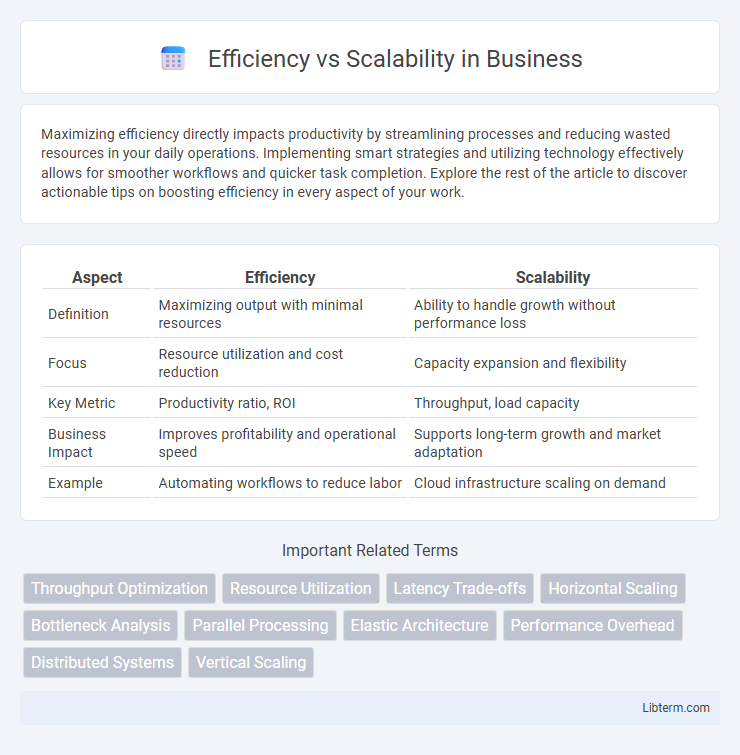Maximizing efficiency directly impacts productivity by streamlining processes and reducing wasted resources in your daily operations. Implementing smart strategies and utilizing technology effectively allows for smoother workflows and quicker task completion. Explore the rest of the article to discover actionable tips on boosting efficiency in every aspect of your work.
Table of Comparison
| Aspect | Efficiency | Scalability |
|---|---|---|
| Definition | Maximizing output with minimal resources | Ability to handle growth without performance loss |
| Focus | Resource utilization and cost reduction | Capacity expansion and flexibility |
| Key Metric | Productivity ratio, ROI | Throughput, load capacity |
| Business Impact | Improves profitability and operational speed | Supports long-term growth and market adaptation |
| Example | Automating workflows to reduce labor | Cloud infrastructure scaling on demand |
Defining Efficiency and Scalability
Efficiency measures resource utilization, such as CPU, memory, and time, to perform a task optimally within fixed constraints. Scalability evaluates a system's ability to maintain or improve performance as the workload or number of users increases. Defining efficiency emphasizes minimizing waste and maximizing throughput, while scalability focuses on growth capacity and adaptability under expanded demands.
Key Differences Between Efficiency and Scalability
Efficiency measures how well a system utilizes resources to complete tasks with minimal waste, emphasizing optimal performance under current conditions. Scalability refers to the ability of a system to handle increased workloads or growth without compromising performance. Key differences include efficiency focusing on resource optimization at a given scale, while scalability emphasizes maintaining performance as demand and system size expand.
Importance in Modern Systems Design
Efficiency in modern systems design emphasizes optimal resource utilization, minimizing latency and reducing energy consumption to enhance performance and cost-effectiveness. Scalability ensures systems can handle increasing workloads seamlessly, maintaining reliability and user experience as demand grows. Balancing efficiency and scalability is crucial for designing robust architectures that adapt to evolving business needs while optimizing operational overhead.
Measuring Efficiency: Metrics and Methods
Measuring efficiency in computing systems involves evaluating resource utilization, execution time, and throughput to determine performance relative to input size or workload. Key metrics include CPU utilization, memory usage, latency, and energy consumption, while methods such as benchmarking, profiling, and simulation provide quantitative data for analysis. Accurate efficiency measurement enables optimization by identifying bottlenecks and balancing speed with resource costs, crucial for scalable system design.
Assessing Scalability: Key Indicators
Assessing scalability involves measuring key indicators such as system throughput, latency under increased workloads, and resource utilization efficiency. Monitoring how performance metrics change with added users or data volume reveals potential bottlenecks and capacity limits. Evaluating horizontal and vertical scaling capabilities ensures the system can maintain efficiency while expanding to meet demand.
Trade-offs Between Efficiency and Scalability
Efficiency often demands minimal resource consumption and fast execution times, which can limit a system's capacity to handle increased workloads. Scalability emphasizes the ability to maintain performance while expanding, sometimes requiring additional resources that reduce overall efficiency. Balancing these trade-offs requires strategic architecture decisions to optimize both resource utilization and growth potential.
Real-World Examples and Case Studies
Efficiency in real-world systems often emphasizes optimizing resources to achieve maximum output with minimal waste, as demonstrated by Toyota's Lean Manufacturing reducing production costs while maintaining quality. Scalability, crucial for companies like Netflix, involves designing infrastructure that seamlessly handles exponential user growth without performance degradation. Case studies reveal that balancing efficiency and scalability requires adaptive strategies; Amazon Web Services exemplifies this by providing elastic cloud solutions that optimize resource use while supporting massive scalability.
Strategies for Achieving Both
Balancing efficiency and scalability requires using modular architecture that allows systems to grow without significant performance loss. Implementing resource allocation strategies like load balancing and dynamic scaling optimizes system responsiveness and cost-effectiveness. Leveraging cloud-native technologies and microservices facilitates seamless scalability while maintaining operational efficiency.
Common Pitfalls to Avoid
Efficiency often decreases when attempting to scale systems without proper design, leading to resource bottlenecks and increased latency. Common pitfalls include ignoring load distribution, underestimating data storage needs, and failing to optimize algorithms for parallel processing. Avoiding these issues requires thorough capacity planning, implementing scalable architectures like microservices, and continuous performance monitoring.
Best Practices for Balancing Efficiency and Scalability
Optimizing system performance requires balancing efficiency and scalability through techniques such as load balancing, caching, and asynchronous processing. Implementing microservices architecture enables independent scaling of components, improving resource utilization without sacrificing speed. Employing monitoring tools and auto-scaling policies ensures that systems dynamically adjust to varying workloads while maintaining optimal efficiency levels.
Efficiency Infographic

 libterm.com
libterm.com